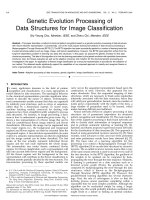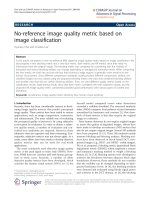CNN image classification
Bạn đang xem bản rút gọn của tài liệu. Xem và tải ngay bản đầy đủ của tài liệu tại đây (161.42 KB, 15 trang )
from google.colab import files
from google.colab import drive
drive.mount('/content/drive')
Drive already mounted at /content/drive; to attempt to forcibly remount, call drive.mount("/conte
## Convolutional Neural Network - Image Classification
from tensorflow.compat.v1 import ConfigProto
from tensorflow.compat.v1 import InteractiveSession
config = ConfigProto()
config.gpu_options.per_process_gpu_memory_fraction = 0.5
config.gpu_options.allow_growth = True
session = InteractiveSession(config=config)
# Convolutional Neural Network
# Importing the libraries
import tensorflow as tf
from tensorflow.keras.preprocessing.image import ImageDataGenerator
tf.__version__
'2.5.0'
# Part 1 - Data Preprocessing
# Preprocessing the Training set
train_datagen = ImageDataGenerator(rescale = 1./255,shear_range = 0.2,zoom_range = 0.2,horizontal_flip
training_set = train_datagen.flow_from_directory('/content/chest_xray/chest_xray/train',target_size = (
Found 5216 images belonging to 2 classes.
# Preprocessing the Test set
test_datagen = ImageDataGenerator(rescale = 1./255)
test_set = test_datagen.flow_from_directory('/content/chest_xray/chest_xray/test',target_size = (64, 64
Found 624 images belonging to 2 classes.
from tensorflow.keras.layers import Conv2D
from tensorflow.keras.layers import Dense
from tensorflow.keras.regularizers import l2
# Part 2 - Building the CNN
# Initialising the CNN
cnn = tf.keras.models.Sequential()
# Step 1 - Convolution
cnn.add(tf.keras.layers.Conv2D(filters=32,padding="same",kernel_size=3, activation='relu', strides=2, i
# Step 2 - Pooling
cnn.add(tf.keras.layers.MaxPool2D(pool_size=2, strides=2))
# Adding a second convolutional layer
cnn.add(tf.keras.layers.Conv2D(filters=32,padding='same',kernel_size=3, activation='relu'))
cnn.add(tf.keras.layers.MaxPool2D(pool_size=2, strides=2))
# Step 3 - Flattening
cnn.add(tf.keras.layers.Flatten())
# Step 4 - Full Connection
cnn.add(tf.keras.layers.Dense(units=128, activation='relu'))
# Step 5 - Output Layer
#cnn.add(tf.keras.layers.Dense(units=1, activation='sigmoid'))
## For Binary Classification
cnn.add(Dense(1, kernel_regularizer=tf.keras.regularizers.l2(0.01),activation ='linear'))
## for mulitclassification
cnn.add(Dense(4, kernel_regularizer=tf.keras.regularizers.l2(0.01),activation ='softmax'))
cnn.compile(optimizer = 'adam', loss = 'squared_hinge', metrics = ['accuracy'])
cnn.summary()
Model: "sequential"
_________________________________________________________________
Layer (type)
Output Shape
Param #
=================================================================
conv2d (Conv2D)
(None, 32, 32, 32)
896
_________________________________________________________________
max_pooling2d (MaxPooling2D) (None, 16, 16, 32)
0
_________________________________________________________________
conv2d_1 (Conv2D)
(None, 16, 16, 32)
9248
_________________________________________________________________
max_pooling2d_1 (MaxPooling2 (None, 8, 8, 32)
0
_________________________________________________________________
flatten (Flatten)
(None, 2048)
0
_________________________________________________________________
dense (Dense)
(None, 128)
262272
_________________________________________________________________
dense_1 (Dense)
(None, 1)
129
_________________________________________________________________
dense_2 (Dense)
(None, 4)
8
=================================================================
Total params: 272,553
Trainable params: 272,553
Non-trainable params: 0
_________________________________________________________________
# Part 3 - Training the CNN
# Compiling the CNN
cnn.compile(optimizer = 'adam', loss = 'hinge', metrics = ['accuracy'])
# Training the CNN on the Training set and evaluating it on the Test set
r=cnn.fit(x = training_set, validation_data = test_set, epochs = 30)
63/ 63 [
]
85s 5
s/step
oss: 0.88
Epoch 2/30
163/163 [==============================] - 81s 499ms/step - loss: 0.8818
Epoch 3/30
163/163 [==============================] - 84s 513ms/step - loss: 0.8802
Epoch 4/30
163/163 [==============================] - 87s 533ms/step - loss: 0.8795
Epoch 5/30
163/163 [==============================] - 85s 521ms/step - loss: 0.8790
Epoch 6/30
163/163 [==============================] - 84s 517ms/step - loss: 0.8788
Epoch 7/30
163/163 [==============================] - 86s 526ms/step - loss: 0.8786
Epoch 8/30
163/163 [==============================] - 87s 531ms/step - loss: 0.8786
Epoch 9/30
163/163 [==============================] - 83s 512ms/step - loss: 0.8786
Epoch 10/30
accu acy: 0.
- accuracy: 0.7429 - v
- accuracy: 0.7429 - v
- accuracy: 0.5234 - v
- accuracy: 0.0000e+00
- accuracy: 0.1597 - v
- accuracy: 0.6183 - v
- accuracy: 0.7245 - v
- accuracy: 0.7429 - v
163/163 [==============================] - 83s 511ms/step - loss: 0.8785 - accuracy: 0.7429 - v
Epoch 11/30
163/163 [==============================]
Epoch 12/30
163/163 [==============================]
Epoch 13/30
163/163 [==============================]
Epoch 14/30
163/163 [==============================]
Epoch 15/30
163/163 [==============================]
Epoch 16/30
163/163 [==============================]
Epoch 17/30
163/163 [==============================]
Epoch 18/30
163/163 [==============================]
Epoch 19/30
163/163 [==============================]
Epoch 20/30
163/163 [==============================]
Epoch 21/30
163/163 [==============================]
Epoch 22/30
163/163 [==============================]
Epoch 23/30
163/163 [==============================]
Epoch 24/30
163/163 [==============================]
Epoch 25/30
163/163 [==============================]
Epoch 26/30
163/163 [==============================]
- 84s 518ms/step - loss: 0.8785 - accuracy: 0.7429 - v
- 86s 528ms/step - loss: 0.8785 - accuracy: 0.7429 - v
- 84s 514ms/step - loss: 0.8785 - accuracy: 0.7429 - v
- 82s 505ms/step - loss: 0.8785 - accuracy: 0.7429 - v
- 83s 508ms/step - loss: 0.8785 - accuracy: 0.7429 - v
- 85s 519ms/step - loss: 0.8785 - accuracy: 0.7429 - v
- 85s 524ms/step - loss: 0.8785 - accuracy: 0.7429 - v
- 83s 511ms/step - loss: 0.8785 - accuracy: 0.7429 - v
- 83s 512ms/step - loss: 0.8785 - accuracy: 0.7429 - v
- 83s 509ms/step - loss: 0.8785 - accuracy: 0.7429 - v
- 85s 523ms/step - loss: 0.8785 - accuracy: 0.7429 - v
- 85s 521ms/step - loss: 0.8785 - accuracy: 0.7429 - v
- 85s 519ms/step - loss: 0.8785 - accuracy: 0.7429 - v
- 86s 528ms/step - loss: 0.8785 - accuracy: 0.7429 - v
- 86s 526ms/step - loss: 0.8785 - accuracy: 0.7429 - v
- 85s 521ms/step - loss: 0.8785 - accuracy: 0.7429 - v
Epoch 27/30
163/163 [==============================]
Epoch 28/30
163/163 [==============================]
Epoch 29/30
163/163 [==============================]
Epoch 30/30
163/163 [==============================]
- 85s 521ms/step - loss: 0.8785 - accuracy: 0.7429 - v
- 86s 529ms/step - loss: 0.8785 - accuracy: 0.7429 - v
- 86s 526ms/step - loss: 0.8785 - accuracy: 0.7429 - v
- 84s 518ms/step - loss: 0.8785 - accuracy: 0.7429 - v
score = cnn.evaluate(test_set, verbose=0)
print("The Accuracy score is:", score)
The Accuracy score is: [0.9375, 0.625]
# plot the loss
import matplotlib.pyplot as plt
plt.plot(r.history['loss'], label='train loss')
plt.plot(r.history['val_loss'], label='val loss')
plt.legend()
plt.show()
plt.savefig('LossVal_loss')
# plot the accuracy
plt.plot(r.history['accuracy'], label='train acc')
plt.plot(r.history['val_accuracy'], label='val acc')
plt.legend()
plt.show()
plt.savefig('AccVal_acc')
# save it as a h5 file
from tensorflow.keras.models import load_model
cnn.save('model_rcat.h5')
from tensorflow.keras.models import load_model
# load model
model = load_model('model_rcat.h5')
model.summary()
Model: "sequential"
_________________________________________________________________
Layer (type)
Output Shape
Param #
=================================================================
conv2d (Conv2D)
(None, 32, 32, 32)
896
_________________________________________________________________
max_pooling2d (MaxPooling2D) (None, 16, 16, 32)
0
_________________________________________________________________
conv2d_1size
(Conv2D)
(None, 16, 16, 32)
9248
_________________________________________________________________
max_pooling2d_1 (MaxPooling2 (None, 8, 8, 32)
0
_________________________________________________________________
flatten (Flatten)
(None, 2048)
0
_________________________________________________________________
dense (Dense)
(None, 128)
262272
_________________________________________________________________
dense_1 (Dense)
(None, 1)
129
_________________________________________________________________
dense_2 (Dense)
(None, 4)
8
=================================================================
Total params: 272,553
Trainable params: 272,553
Non-trainable params: 0
_________________________________________________________________
# Part 4 - Making a single prediction
import numpy as np
from tensorflow.keras.preprocessing import image
test_image = image.load_img('/content/chest_xray/val/NORMAL/NORMAL2-IM-1427-0001.jpeg', target_size = (
test_image = image.img_to_array(test_image)
test_image=test_image/255
test_image = np.expand_dims(test_image, axis = 0)
result1 = cnn.predict(test_image)
# Part 4 - Making a single prediction
import numpy as np
from tensorflow.keras.preprocessing import image
test_image = image.load_img('/content/chest_xray/val/PNEUMONIA/person1950_bacteria_4881.jpeg', target_s
test_image = image.img_to_array(test_image)
test_image=test_image/255
test_image = np.expand_dims(test_image, axis = 0)
result2 = cnn.predict(test_image)
# Part 4 - Making a single prediction
import numpy as np
from tensorflow.keras.preprocessing import image
test_image = image.load_img('/content/chest_xray/val/NORMAL/NORMAL2-IM-1437-0001.jpeg', target_size = (
test_image = image.img_to_array(test_image)
test_image=test_image/255
test_image = np.expand_dims(test_image, axis = 0)
result3 = cnn.predict(test_image)
predictions1 = np.argmax(result1)
predictions2 = np.argmax(result2)
predictions3 = np.argmax(result3)
print("The prediction That I have :", predictions1)
print("The prediction That I have :", predictions2)
print("The prediction That I have :", predictions3)
The prediction That I have : 1
The prediction That I have : 1
The prediction That I have : 1
categories = {0:'NORMAL',1:'PNEUMONIA'}
print("The prediction Of the Image is : ", categories[predictions1])
print("The prediction Of the Image is : ", categories[predictions2])
print("The prediction Of the Image is : ", categories[predictions3])
The prediction Of the Image is :
The prediction Of the Image is :
The prediction Of the Image is :
PNEUMONIA
PNEUMONIA
PNEUMONIA
# show the image
import matplotlib.pyplot as plt
test_image = image.load_img('/content/chest_xray/val/PNEUMONIA/person1950_bacteria_4881.jpeg', target_s
plt.axis('off')
plt.imshow(test_image)
plt.show()
# show the image
import matplotlib.pyplot as plt
test_image = image.load_img('/content/chest_xray/val/NORMAL/NORMAL2-IM-1437-0001.jpeg', target_size = (
plt.axis('off')
plt.imshow(test_image)
plt.show()
check 0s
completed at 2:20 PM









